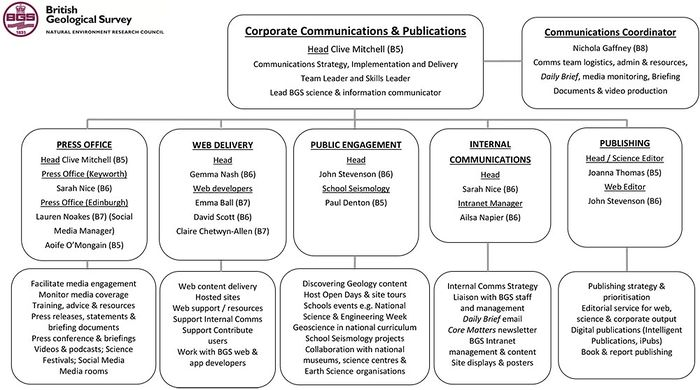OR/14/019 BGS communications: background
| Mitchell, C J, Nice, S E, Stevenson, J P, Thomas, J E, Nash, G V and Noakes, L. 2014. Broadcasting the science stories of BGS. British Geological Survey Internal Report, OR/14/058. |
Current state of communications at the BGS
Prior to November 2006, the communications culture of the BGS had been largely driven by reaction to news events as they happened and managing media requests as they emerged. In 2007, the BGS embarked on a process of formalising its communication planning. This lead to the creation of the BGS Communications team which encompassed the BGS press office, the outreach programme and the web editor. In 2008 a communications strategy was drafted by the communications team leader, Dr Marie Cowan in conjunction with marketing consultants Insidedge (Insidedge, 2008[1]). Although not formally published, this strategy has guided BGS communications over the period 2008 to 2014 (during which time Dr Aoife O’Mongain and Clive Mitchell were the Team Leaders). The key driver for the creation of the new team and its strategic direction was the desire to shift the communications ethos from a reactive to a proactive approach.
In 2013, the BGS Communications Team was incorporated into the BGS Corporate Communications and Publications corporate function alongside web delivery, internal communications and publications. The organogram for the BGS Corporate Communications and Publications corporate function as of April 2014 is shown in Figure 1.
The public profile of the BGS has been successfully raised since the creation of the communications team in 2007. This can be seen in Figure 2 which charts the increase in media enquiries and online media hits. Overall, there has been a four-fold increase since 2006. Figure 2 also shows that there has also been a significant increase in ‘web hits’ (unique visitor sessions) recorded for the BGS website (www.bgs.ac.uk) over the same period. This can in large part be attributed to the attention that the BGS has paid to improving the communication of its science.

BGS Science strategy
In 2014 the BGS released its science strategy for the next decade, Gateway to the Earth: Science for the next decade (BGS, 2014[2]).
The vision for the BGS is as follows:
- “Our vision…is to be a global geological survey, working with new technology and data to understand and predict the geological processes that matter to people’s lives and livelihoods”
The goals of the BGS science strategy are:
- Instrumenting the Earth — Harnessing new technologies so that we understand how geological processes act in real time. This will be important for our future use of the subsurface for groundwater, energy and waste disposal. It will enable us to improve our understanding of subsurface processes and make us better at managing these activities safely and sustainably.
- Use our natural resources responsibly — BGS will continue to research resource security, evaluation and extraction for, amongst others, critical metals, groundwater and shale gas. We will also research energy storage and geological disposal e.g. of radioactive waste and carbon dioxide. BGS science aims to ensure that we get the most out of resources without harming the environment.
- Manage environmental change — BGS specialises in long-term monitoring and observation to detect change that may not be visible day to day. Our analysis looks for tipping points and feedback, and in the future we will build computer models to help predict environmental change and so protect lives and property in a timely and economical way.
- Be resilient to environmental hazards — BGS will use new technologies to improve satellite measurement and real-time monitoring of hazards including earthquakes, volcanoes, tsunamis, landslides, floods and subsidence. This will allow us to assess, model and forecast hazards. It will ultimately help to mitigate their effects and go some way towards improving our resilience to natural hazards.
The BGS will use its new understanding of geological processes and existing research capacity to rise to these global challenges. Its work will be achieved by nurturing our staff, developing new partnerships with universities, institutes and businesses, playing to our core strengths in 3D geology and the national geological database, and by remaining a trusted, independent voice for the geological sciences in the UK and globally.
The new BGS science strategy has informed the redevelopment of the communications strategy outlined in this report and ensures that it fits with the new emphasis and direction of BGS research. This communications strategy will be used to guide the annual communications plan of the BGS which will be issued in line with the financial year.

NB Media enquiries are recorded on the BGS Intranet Data Access (IDA) database; Media hits are recorded using an online media monitoring service and date back to 2001; BGS web hits are the unique visitor sessions and were not collected before July 2000.
References
- ↑ INSIDEDGE. 2008. British Geological Survey Communications Strategy. Draft prepared by Insidedge August 2008.
- ↑ BRITISH GEOLOGICAL SURVEY. 2014. Gateway to the Earth. (Keyworth, Nottingham: British Geological Survey.) Available from https://www.bgs.ac.uk/downloads/start.cfm?id=2895